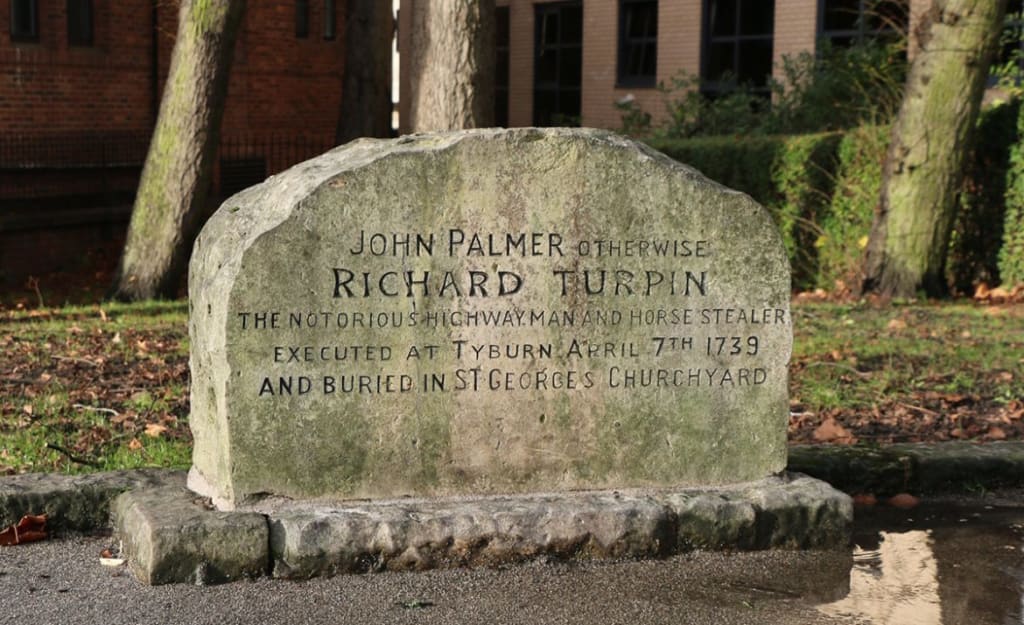Dick Turpin
"I don't want your money, I know where you got it from. By taxing your tenants till they starved"

He was the infamous highwayman of the 1700’s and what we’ve heard about it is more myth than fact. According to myth, he made a 200 mile journey on a jet black horse named Black Bess. He was Dick Turpin.
He was born at the Blue Bell Inn in Hempstead, Essex, and was the fifth of six children. His parents were John Turpin and Mary Elizabeth Parmenter. Dick was baptised on 21st September, 1705, in the same Parish where his parents had married, ten years earlier. John Turpin was a butcher and innkeeper, and it seems that Dick followed his father in becoming a butcher. In about 1725, Dick married Elizabeth Millington and the couple moved to Buckhurst Hill, Essex, where he opened a butcher’s shop.
Dick became involved with the Essex gang (sometimes called the Gregory Gang). They were a gang of deer thieves who needed contacts to help them dispose of the deers, and owning a butcher’s shop, Turpin was useful. Seeing the changing fortunes of the gang, Turpin gave up the butcher’s shop and became the landlord of a public house at Clay Hill. There doesn’t seem to be any evidence that Turpin joined the gang in their thievery then, but he, nevertheless, was a ‘close associate’ by the Summer of 1734.
Over the next few months, the Essex gang struck again and again, stealing and attacking law-abiding homes. On 19th December, the gang, along with Turpin, raided the home of a 73 year old farmer and left with an estimated £300 (possibly £69,000 in today’s money).
The Essex gang continued their reign of terror, stealing from innocent people and moving to London. Turpin stayed in Whitechapel for a while and then moved to Millbank. Now he was ‘working’ with the gang, joining in with their brutal attacks. The Duke of Newcastle offered a reward for information leading to the conviction of “several persons” who had been involved with several violent robberies. Wheeler, who was the youngest at only 15, was caught and soon gave up his ‘friends’. In The London Gazette, Dick Turpin was described thus: “Richard Turpin, a butcher by trade, is a tall fresh coloured man, very much marked by smallpox, about 26 years of age, about five feet nine inches high, lived some time ago in Whitechapel and did lately lodge somewhere about Millbank, Westminster, wears a blue grey coat and a natural wig”.
Realising that they were now being hunted by the authorities, the gang and Turpin went their separate ways into hiding but still met up to do robberies. Eventually, most of the Essex gang were caught and executed. Turpin, however, still managed to elude the authorities and ‘worked’’ alone for a short time as a highwayman doing highway robberies.
He started working alongside Thomas Rowden, and the two started to use Epping Forest, moving on to Blackheath in Hertfordshire and then back to London. There was now a bounty of £100 on their heads. The two separated and Rowden was caught in July, 1736, and transported to the Thirteen Colonies the following year.
Turpin 'disappeared’ in 1736, but spent the night at Puckeridge, with his wife, her maid and a man called Robert Nott. Turpin had arranged this meeting by letter, which had been intercepted by the authorities. Turpin escaped but the others were arrested. The women were freed and Nott was eventually freed because of lack of evidence.
Turpin now ‘worked’ alongside two other highwaymen, Matthew King and Stephen Potter. Again, the two men were caught but Turpin escaped. A reward of £200 was now offered for Turpin’s capture.
Some time in 1737, Turpin was caught. There was a violent encounter with another man and Turpin was, eventually, transferred to York Castle in handcuffs. He did not resist or attempt to escape and it is thought that Turpin had gone into a deep depression after seeing how his life was turning out. He was suspected of sheep and horse stealing (Horse theft became a capital offence in 1545, punishable by death). Turpin was tried for stealing horses and sentenced to death.
On 7th April, 1739, Dick Turpin was taken through York by open cart to Knavesmire, and executed by hanging. An account in The Gentleman's Magazine for 7th April, 1739, notes Turpin’s brashness: “Turpin behaved in an undaunted manner, as he mounted the ladder, feeling his right leg tremble, he spoke a few words to the topsman, then threw himself off, and expir’d in five minutes”.
If you enjoyed this article, go on over to my website for similar articles: https://sarah-s-story-book.webnode.co.uk/
About the Creator
Ruth Elizabeth Stiff
I love all things Earthy and Self-Help
History is one of my favourite subjects and I love to write short fiction
Research is so interesting for me too






Comments
There are no comments for this story
Be the first to respond and start the conversation.